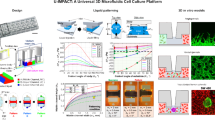Abstract
In this study, we develop a new concept for multiplexed and localized cell co-culture. This cell chip consists of a polystyrene spin-coated solid support bearing gold-bottomed microwells. The cell-chip support is fabricated as follows: (i) electrosputtering of a thin layer of gold (40 nm) onto a polycarbonate substrate, (ii) spin coating of a polystyrene thin film (500 ± 50 nm) over the gold layer, followed by (iii) polystyrene etching through the spotting of toluene nanovolume (300–900 pL). In each gold-bottomed microwell, a small population of adherent cells (approx. 100 cells) can be cultured. In this miniaturized system, different cell lines can be co-cultured on a 1-cm2 surface, opening the way to multiplexed cell-chip development. In order to keep the cells in a properly hydrated environment and to physically retain them before they adhere, a biocompatible alginate polymer was used during the robotized micropipetting. This approach allows for the encapsulation of the cell in a very small volume (50 nL), directly in the microwells. After 24 h of culture, the cells adhered on the gold bottom of the microwells, and the alginate matrix was removed by addition of calcium-free culture medium.
Graphical Abstract
Multiplex culture of cells was obtained using in situ produced microwells and encapsulated cells. The microwells are produced by organic solvent etching (nanovolume spotting) of a spin-coated polystyrene thin film, and the living multiple cell line deposition is obtained using on-site encapsulation in an alginate bead.








Similar content being viewed by others
References
Tanase M, Felton EJ, Gray DS, Hultgren A, Chen CS, Reich DH (2005) Assembly of multicellular constructs and microarrays of cells using magnetic nanowires. Lab Chip 5:598–605
Chandra RA, Douglas ES, Mathies RA, Bertozzi CR, Francis MB (2006) Programmable cell adhesion encoded by DNA hybridization. Angew Chem Int Ed Engl 45:896–901
Chen CS (1997) Geometric control of cell life and death. Science 276:1425–1428
Wood DK, Weingeist DM, Bhatia SN, Engelward BP (2010) Single cell trapping and DNA damage analysis using microwell arrays. PNAS 107:10008–10013
Rettig JR, Folch A (2005) Large-scale single-cell trapping and imaging using microwell arrays. Anal Chem 77:5628–5634
Di Carlo D, Wu LY, Lee LP (2006) Dynamic single cell culture array. Lab Chip 6:1445–1449
Revzin A, Sekine K, Sin A, Tompkins RG, Toner M (2005) Development of a microfabricated cytometry platform for characterization and sorting of individual leukocytes. Lab Chip 5:30–37
Tien J, Nelson CM, Chen CS (2002) Fabrication of aligned microstructures with a single elastomeric stamp. Proc Natl Acad Sci USA 99:1758–1762
Suzuki I, Sugio Y, Moriguchi H, Jimbo Y, Yasuda K (2004) Modification of a neuronal network direction using stepwise photo-thermal etching of an agarose architecture. J Nanobiotechnol 2:7
Alvarez GS, Foglia ML, Copello GJ, Desimone MF, Diaz LE (2009) Effect of various parameters on viability and growth of bacteria immobilized in sol–gel-derived silica matrices. Appl Microbiol Biotechnol 82:639–646
Liu L, Shang L, Guo S, Li D, Liu C, Qi L, Dong S (2009) Organic–inorganic hybrid material for the cells immobilization: long-term viability mechanism and application in BOD sensors. Biosens Bioelectron 25:523–526
Fernandes TG, Kwon SJ, Lee MY, Clark DS, Cabral JM, Dovdick JS (2008) Immunofluorescence assay for high-throughput analysis of target proteins. Anal Chem 80:6633–6639
Lee KH, No DY, Kim SH, Ryoo JH, Wong SF, Lee SH (2011) Diffusion-mediated in situ alginate encapsulation of cell spheroids using microscale concave well and nanoporous membrane. Lab Chip 11:1168–1173
Lecault V, Vaninsberghe M, Sekulovic S, Knapp DJ, Wohrer S, Bowden W, Viel F, McLaughlin T, Jarandehei A, Miller M, Falconnet D, White AK, Kent DG, Copley MR, Taghipour F, Eaves CJ, Humphries RK, Piret JM, Hansen CL (2011) High-throughput analysis of single hematopoietic stem cell proliferation in microfluidic cell culture arrays. Nat Methods 8(7):581–586
Pai JH, Kluckman K, Cowley DO, Bortner DM, Sims CE, Allbritton NL (2013) Efficient division and sampling of cell colonies using microcup arrays. Analyst 138:220–228
Wang Z, Kim MC, Marquez M, Thorsen T (2007) High-density microfluidic arrays for cell cytotoxicity analysis. Lab Chip 7:740–745
Köster S, Angilè FE, Duan H, Agresti JJ, Wintner A, Schmitz C, Rowat AC, Merten CA, Pisignano D, Griffiths AD, Weitz DA (2008) Drop-based microfluidic devices for encapsulation of single cells. Lab Chip 8:1110–1115
Beamson G, Briggs D (1992) The XPS of polymer database. Surface Spectra, Chichester
Vickerman JC, Briggs D (2001) ToF–SIMS: materials analysis by mass spectrometry, 2nd edn. Surface Spectra, Chichester
Mandon CA, Diaz C, Arrigo AP, Blum LJ (2005) Chemical stress sensitive luminescent human cells: molecular biology approach using inducible Drosophila melanogaster hsp22 promoter. Biochem Biophys Res Commun 335:536–544
Kawase T, Sirringhaus H, Friend RH, Shimoda T (2001) Inkjet printed via-hole interconnections and resistors for all-polymer transistor circuits. Adv Mater 13:1601–1605
Piwowar AM, Lockyer N, Vickerman JC (2008) Investigation of molecular weight effects of polystyrene in ToF–SIMS using C-60(+) and Au+ primary ion beams. Appl Surf Sci 255:912–915
Eynde XV, Weng LT, Bertrand P (1997) Influence of tacticity on polymer surfaces studied by ToF–SIMS. Surf Interface Anal 25:41–45
Vickerman JC, Gilmore IS (2009) Surface analysis: the principal techniques, 2nd edn. Wiley, Chichester
DeMali KA, Barlow CA, Burridge K (2002) Recruitment of the Arp2/3 complex to vinculin: coupling membrane protrusion to matrix adhesion. J Cell Biol 159:881–891
Wiesner S, Lange A, Fässler R (2006) Local call: from integrins to actin assembly. Trends Cell Biol 16:327–329
Yusof A, Keegan H, Spillane CD, Sheils OM, Martin CM, O’Leary JJ, Zengerle R, Koltay P (2011) Inkjet-like printing of single-cells. Lab Chip 11:2447–2454
Author information
Authors and Affiliations
Corresponding author
Electronic supplementary material
Below is the link to the electronic supplementary material.
Rights and permissions
About this article
Cite this article
Berthuy, O.I., Mandon, C.A., Corgier, B.P. et al. Material surface engineering for multiplex cell culture in microwell. J Mater Sci 49, 4481–4489 (2014). https://doi.org/10.1007/s10853-014-8145-z
Received:
Accepted:
Published:
Issue Date:
DOI: https://doi.org/10.1007/s10853-014-8145-z




